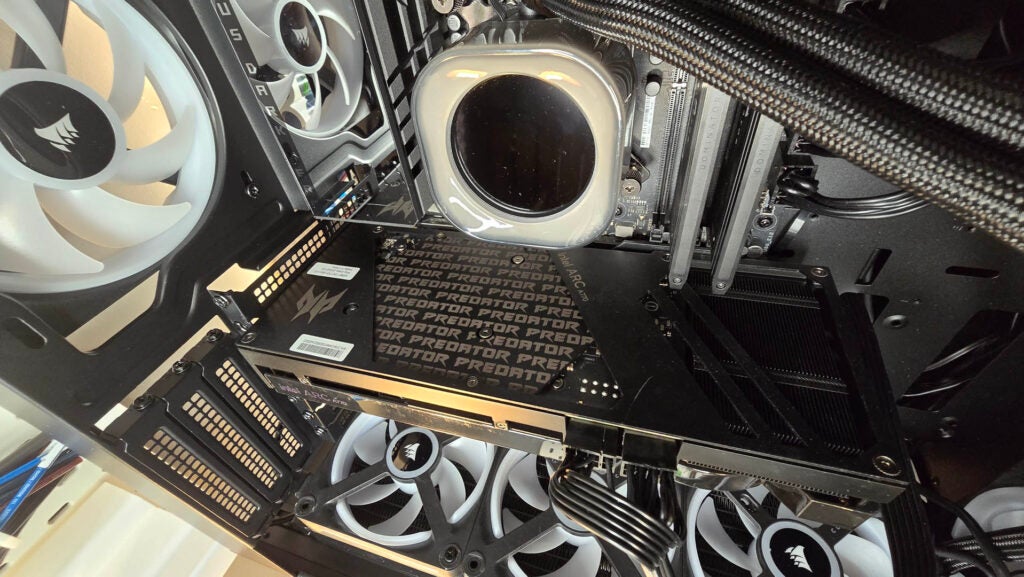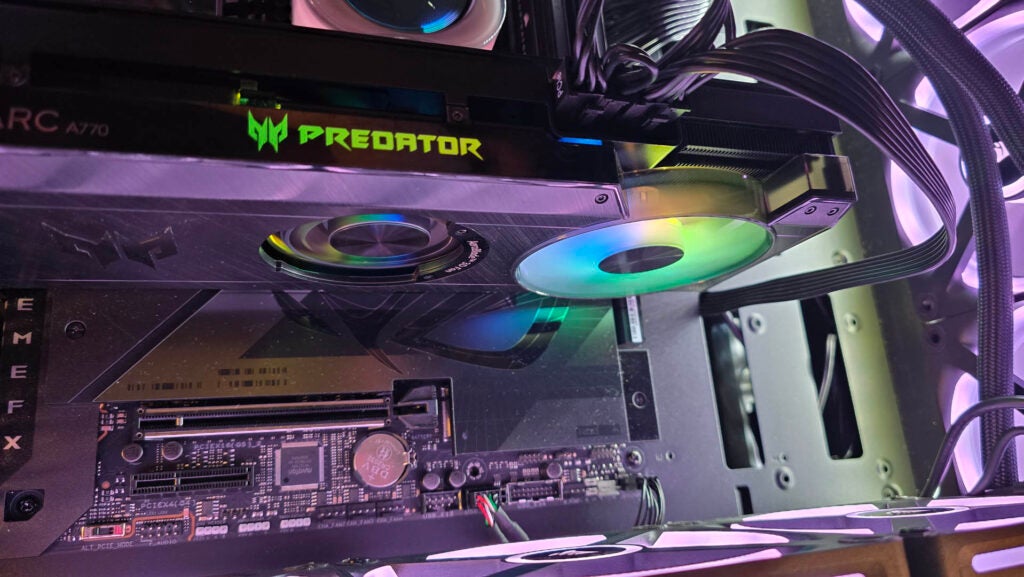Verdict
The Intel Arc A770 is a bizarre graphics card. Compared to its smaller sibling, the A750, it just doesn’t quite provide the performance you’d expect, particularly given the much heftier price tag. There are solid frame rates at 1080p and 1440p and that 16GB of VRAM does go a long way but it can’t keep up with rivals.
Pros
- Good performance for 1080p gaming
- 60+ fps at 1440p
- Quiet card design
Cons
- Pricing isn’t competitive
- Card aesthetics lacking
-
Intel Arc AlchemistThanks to a 7nm manufacturing process provided by TSMC, Intel’s Alchemist architecture remains competitive. -
Strong graphical memory16GB of GDDR6 comes as standard with the Intel Arc A770. That should provide plenty of future-proofing, for 1440p gaming. -
Intel’s answer to DLSSThere’s an awesome amount of Tensor cores in the A770, and Intel’s built its own form of DLSS as well in the form of XeSS.
Introduction
The Intel Arc A770 is Team Blue’s first flagship graphics card it has ever launched. It takes a lot to get into the GPU industry and a huge amount of investment to bring a product to market that can challenge the already well-established brands of both AMD and Nvidia.
For Intel, it’s refrained from going all out, building massive flagships capable of demolishing 4K gaming at a whim, and instead opted to target 1440p as its resolution of choice. That’s quite an intelligent move, given the bulk of gamers are still using monitors in the 1080p and 1440p range, at least according to the latest Steam hardware surveys. That’s not exactly a bad thing either, given how many fantastic gaming monitors there are available right now.
Still, it does make the Intel Arc A770, a little more underwhelming than the likes of Nvidia’s recently released RTX 4080 Super, or AMD’s RX 7800 XT. No, this is a card with a very specific target in mind, however, unlike its A750 sibling, this one might have hit one too many roadblocks on its way to greatness to make it shine.
Specs
- Alchemist architecture features a modular design
- Multiple VRAM variants available
- Polarising pricing compared to A750
At its heart, the A770 is built off of TSMC’s N6 7nm manufacturing process, combined with Intel’s first GPU architecture in the form of Alchemist. It’s based off of a modular design, utilizing multiple chiplets to form the GPU. That gives Intel a significant advantage, as it can stack as many chiplets (or Xe cores) as it wants together, to create its card at any size it likes, as long as it can deliver the power to it, and regulate temperatures as it does so. This also minimizes cost, as it’s less complex than manufacturing a single monolithic design like Nvidia does.


As for the core stats, the A770 features 32 Xe cores. Those come with 4,096 shading cores (think CUDA cores), 256 TMUs, 128 ROPs, and 32 “ray tracing units”. Similar to the XE Cores, the ray tracing units are comprised of a number of separate components, in this case with the 32 you get 1,024 tensor cores, 512 execution units, and 8 render slices total.
Clock speeds are fairly high up there too, with a core clock of 2100 MHz and a max boost clock of 2400 MHz. Interestingly, throughout my testing, the Arc A770 stuck resolutely to those figures. That’s quite unique as most aftermarket cards with competing GPUs tend to clock much higher than Nvidia or AMD’s recommended max boost clocks.
The A770 is also available in two separate VRAM SKUs, 8GB and 16 GB. There’s about a $20 price difference between the two. That’s kinda weird, because well, why would you buy the 8GB one, that being the case? What’s less impressive however is the overall price right. The A770 is available at $350 or thereabouts, which, given the performance it can dish out, is not ideal, and not a patch on something like the A750, but more on that later.
Test Setup
Over the last two weeks, I’ve heavily tested the Intel Arc A770 GPU, alongside a number of its competitors. I’ve pushed it to the limit, benchmarking it across several different scenarios, including everything from some of the most taxing AAA games out there to aggressive synthetic tests and everything in between. To do that, I’ve built a fairly impressive test bed, all based around the Core i9-14900K, one of the best CPUs out there.
CPU: Intel Core i9-14900K
RAM: 32GB (2x16GB) Corsair Dominator Titanium @ 7200
Motherboard: ASUS ROG Maximus Z790 Dark Hero
CPU Cooler: Corsair iCUE Link H150i LCD 360mm AIO
Cooling: 8x Corsair iCUE Link QX120 120mm fans
PSU: 1200W Corsair RMx Shift 80+ Gold PSU
SSD: 2TB Gigabyte Aorus Gen5 12000 M.2 PCIe 5.0 SSD
Case: Geometric Future Model 8 Dharma
For our gaming tests, I’m using a broad mix of titles, some including ray tracing (with DLSS and AI upscaling disabled), some on Vulkan, and others on DX12 as well. I’ve also used 3D Mark’s Fire Strike, Speedway, and Port Royal benchmarks, alongside Blender’s own integrated benchmarks. This gives us a really good indicator of how these cards perform in these environments.


In all of my testing, I use the Ultra or highest graphical preset wherever possible. That does include Ray Tracing presets for the likes of Cyberpunk. This means we can easily repeat our testing, without introducing any unwanted variables, and also allows you at home to compare your own machines easily with our results here to get a rough idea of how your own GPU compares.
Performance and Benchmarks
- Solid 1080p performance
- Poor price for performance
- 1440p sweet spot is possible for now
So, gaming performance. Overall, in isolation, the A770 does perform well. At 1080p average frame across all titles landed at 83.43 fps, at 1440p that drops to 61.57 fps, and at 4K it floats around the 34.14 fps mark. Those are solid numbers, particularly given Cyberpunk 2077 really does pull that average down quite aggressively, thanks to its performance-impacting ray tracing combined with our choice to disable AI upscaling for our stock tests.
Interestingly, it’s less AMD and Nvidia, that cause Intel’s A770 problems, but more its own lower-spec sibling, the A750. In comparison, that scored 74.14, 54, and 29 fps across those same resolutions. That’s a 14% performance increase going from the A750 8GB to the A770 16GB across all three resolutions combined and averaged out. Now yes, that is still a sizable jump, sure, but the price increase between those two cards is 67%. That is what really brings the A770 down. In fact, in my testing, I found the AMD RX 7600 actually beat the Arc A770 in 1080p average performance by 2 fps and lost by 3fps at 1440p, but it costs $80 less. That’s a problem.
Still, Red Dead Redemption II on its Ultra preset, hit an impressive 44 fps at 4K, Borderlands 3 hit 41 and Total War Warhammer 3 managed 28 fps as well, so there’s some decent performance to be had at 4K with this GPU.
Ray Tracing and Upscaling
- Intel XeSS is potent, but not quite as good as DLSS
- XeSS isn’t supported across all titles
- Overall ray tracing performance is pretty good
I’ve also taken the opportunity to put the Intel Arc A770 through a number of different ray tracing and AI upscaling scenarios as well. To do this, I’ve tested it across four separate runs, in different configurations on three different titles. Those titles being, F1 2022, Cyberpunk 2077, and Shadow of the Tomb Raider.
These runs use a multitude of different combinations of settings, with or without ray tracing, combining that with or without AI upscaling. I’ve leaned into each brand’s own respective AI upscaling tech for these tests (XeSS for Intel, DLSS for Nvidia, and FSR 2.0 for AMD) wherever possible. However, it’s worth noting that XeSS and FSR 2.0 are open source and are compatible with all GPUs, whereas DLSS isn’t. Additionally, some titles don’t support XeSS (F1 2022), or FSR 2.0 (Shadow of the Tomb Raider). All tests are performed at 4K.
With that said, the Arc A770 does particularly well here. Ray tracing performance across Tomb Raider managed 30 fps, increasing to 44 with XeSS, and CyberPunk 2077 went all the way from an unplayable 10fps to 28 fps. The latter is likely as XeSS alleviates some of the memory bandwidth pressures that Cyberpunk’s textures place on the VRAM itself.
It’s still not quite as powerful as Nvidia’s now well-developed DLSS 3.0, but a free boost in performance, with minimal drawbacks is no bad thing.
Power Consumption and Temperature
Similarly to the Intel Arc A750, the A770 is incredibly power hungry, over the course of my time benchmarking, total system power draw topped out at an impressive 657.1W. That’s only 13W behind Asus’s ROG Strix Gaming RTX 4080 Super OC I tested earlier this year. Idle power draw was also significantly higher, averaging 205.7W making it the hungriest card we’ve tested here at Trusted this year.
Temperatures though, remained within stable parameters, topping out at 89.0 C, similar to the RTX 4070 Ti Super.
Latest deals
Should you buy it?
You want a 1440p graphics card at $350
60fps at 1440p is easy as pie for the Intel Arc A770, combine that with Acer’s BiFrost Predator design, and you’ll have a super slick quiet GPU that can drive even the latest games at 60 fps at WQHD.
You’re looking for really good value
Sadly, the A770 struggles in the value department at its current price. If you’re looking for a better value option the A750 is a far better bet, with a lot less investment, although its 8GB of VRAM may limit you later on.
Final Thoughts
Intel’s Arc A770 is an interesting GPU. For its first debut onto the scene, Intel really has done a spectacular job of breaking into an incredibly competitive market. One that’s very much dominated by the big two. However, the A770 just lacks the performance necessary to justify its $350 price tag. It’s certainly not one of the best GPUs you can find, not at that price anyway.
If you’re looking for power, and are keen to game at 1440p at high frame rates, or even 4K at 60, then the RTX 4070 Super is the card to pick. If you’re looking for a GPU that will perform similarly, but for $100 less, than something like Intel’s own Arc A750 or the AMD RX 7600 XT are far better picks.
How we test
Each of the graphics cards we test is installed into a dedicated test-bed. After which point multiple different benchmarks are run to stress test the card, at a variety of different resolutions. We also monitor power draw and temperature throughout this procedure.
tested in a dedicated test pc
power draw and temperature monitored
FAQs
It’s not quite there for 4K gaming just yet, in our testing it delivered on average around 34.14 fps across all of our benchmarks
Trusted Reviews test data
Peak temperature
Horizon Zero Dawn frame rate (4K)
Horizon Zero Dawn frame rate (Quad HD)
Horizon Zero Dawn frame rate (Full HD)
Cyberpunk 2077 (4K)
Cyberpunk 2077 (Quad HD)
Cyberpunk 2077 (Full HD)
F1 22 (4K)
F1 22 (Quad HD)
F1 22 (Full HD)
Total War: Warhammer 3 (4K)
Total War: Warhammer 3 (Quad HD)
Total War: Warhammer 3 (Full HD)
Power consumption (idle)
Power consumption (under stress)











